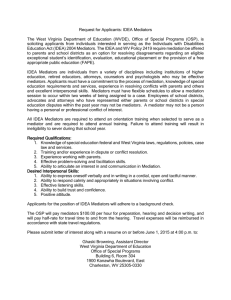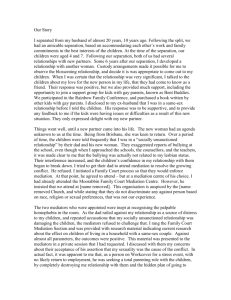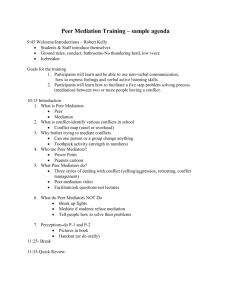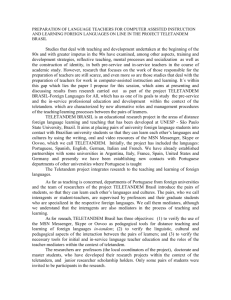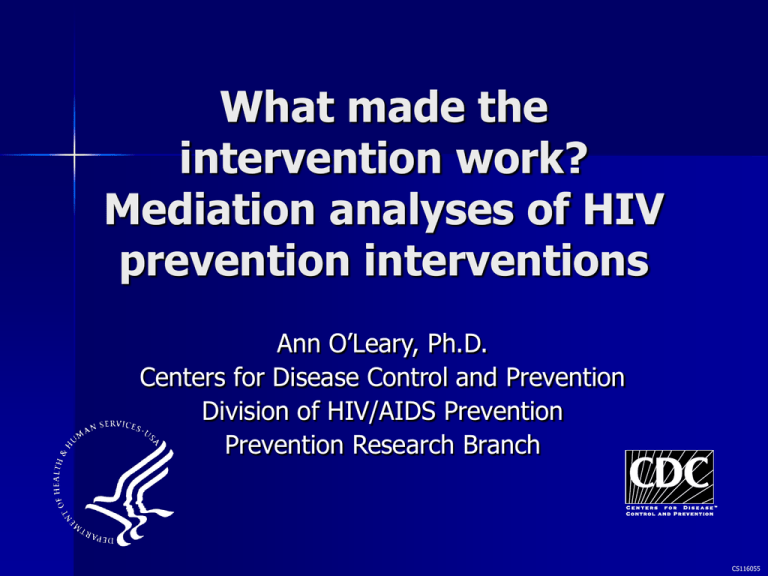
What made the
intervention work?
Mediation analyses of HIV
prevention interventions
Ann O’Leary, Ph.D.
Centers for Disease Control and Prevention
Division of HIV/AIDS Prevention
Prevention Research Branch
CS116055
HIV Risk Reduction
Interventions
Many behavioral interventions designed to
reduce sexual risk behavior have been
developed for various at-risk populations.
These interventions, based on behavioral
theory, contain many theoretically-derived
activities representing different theoretical
elements.
For most of these interventions, we do not
know which elements may have been
responsible for intervention effectiveness.
Elements of SCT and TPB
Social Cognitive Theory
-Self-efficacy to perform behavior (SE)
-Expected outcomes of behavior (OEs)
Theory of Planned behavior
-Attitudes (expected outcomes and
value of outcomes)
-Norms (approval of behavior by close
others and motivation to comply)
-Perceived behavioral control (SE)
Examples of application of
theory in HIV interventions
Build skills and self-efficacy via modeling
and practice, e.g. using condoms,
negotiating use with partner
Change expected outcome beliefs, e.g., that
condoms reduce pleasure
Build peer norms/approval within groups
Most behavioral HIV
interventions have multiple
theoretical components
Mediation analysis provides a way to identify
effective and ineffective components
Not as rigorous as randomizing people to receive
individual components, but much more efficient!
May help to refine interventions to become more
cost-effective by emphasizing mediator-based
components with demonstrated importance for a
particular population and de-emphasizing others
To conduct mediation
analyses, your theoretical
elements must:
Be instantiated in the intervention
Be measured in evaluation
assessments
Mediation analysis
Uses measures of theoretical factors
driving the intervention and assessed
in study (potential mediators)
Identifies factors changed significantly
by the intervention (step 1)
Tests whether inclusion of mediator
attenuates strength of intervention
effect on dependent variable (step 2)
Independent
Variable
Dependent
Variable
Treatment
condition
Unprotected
sex
Independent
Variable
Dependent
Variable
Treatment
condition
Unprotected
sex
Mediators
Generic Mediation Model
Intervention
Mediators & NS factors
Mediator 1
Mediator 2
Mediator 3
FU assessment
FU assessment
Sex risk
Mediators
Sex risk
Mediators
FU assessment
FU assessment
Sex risk
Mediators
Sex risk
Mediators
Nonspecific factors
(demand;
attention;
assessment
reactivity)
BL Assessment
Randomization
Sex risk
Mediators
Comparison
Nonspecific factors
(demand; attention;
assessment
reactivity)
Goals of talk
Describe three HIV intervention
studies with different populations
Briefly review methods and outcome
results
Show results of mediation analyses for
each of these studies
Sister-to-Sister
Outcome paper:
Jemmott, L. S., Jemmott, J. B, & O’Leary, A.
(2007). Effects on sexual risk behavior and
STD rate of brief HIV/STD prevention
interventions for African American women in
primary care settings. AJPH, 97,1034-1040.
Mediation paper:
O’Leary, A., Jemmott, L. S., & Jemmott, J. B.
(2008). Mediation analysis of an effective
sexual risk reduction intervention for
women. Health Psychology, 27, 180-4.
Sister-to-Sister
NINR-funded study conducted at a hospital
in inner-city Newark NJ
564 African American women randomized to
single-session intervention conditions: Skillbuilding, Information, Control
Follow-up for one year
Skill intervention produced significant effects
on behavior; STD incidence at 12 months
Sister-to-Sister
Potential Mediators
-Condom knowledge
Intervention: Provide factual information
Assessment e.g.: The condom should be unrolled before it is put on.
-Hedonistic condom OEs
Intervention: Show ways to make condoms more pleasurable
Assessment e.g.: Condoms interrupt the flow of sex.
-Partner reaction OEs
Intervention: Develop negotiation strategies specific to partner
Assessment e.g.: My partner will be angry if I ask him to use a condom.
-Partner approval OEs
Intervention: Develop negotiation strategies specific to partner
Assessment e.g.: Would your partner approve or disapprove of condom use?
Sister-to-Sister
Potential Mediators (cont.)
-SE for sexual impulse control
Intervention: Encourage practice, e.g., to stop sex to get a condom
Assessment, e.g.: I can say no to sex if my partner and I do not
have a condom.
-SE for carrying condoms
Intervention: Give condom keychain.
Assessment, e.g.: It is easy for me to have condoms with me.
-SE for condom use
Intervention: Modeling and practice of condom use; negotiation
Assessment, e.g.: I am sure I could get my partner to use condoms,
even if he does not want to.
Sister-to-Sister
Intervention
Mediators & NS factors
-Condom knowledge
-Hedonistic condom OEs
-Partner reaction OEs
-Partner approval OEs
-SE for sexual impulse
control
-SE for carrying condoms
-SE for condom use
BL Assessment
3; 6 –month FU
12-month FU
Sex risk
Mediators
Sex risk
Mediators
3; 6-month FU
1 2-month FU
Sex risk
Mediators
Sex risk
Mediators
Randomization
Sex risk
Mediators
Comparison
Nonspecific factors
OE=outcome expectancy
SE=self-efficacy
Summary:
Sister-to-Sister
Skills intervention effective in changing risk
behavior
Partner resistance and self-efficacy
significant in univariate mediation analyses
Only self-efficacy remained significant in
multivariate mediation analysis
Suggests the primacy of women’s skills at
negotiation over partner characteristics,
contrary to common opinion
South African Adolescent
Health Promotion Project
Outcome paper:
Jemmott, J. B., Jemmott, L. S., O’Leary, A.
et al. Cluster-randomized controlled trial of
an HIV/STD risk reduction intervention for
South African adolescents. Under revision,
Lancet.
Mediation paper:
O’Leary, A. et al., in preparation.
South African Adolescent
Health Promotion Project
NIMH-funded study conducted in
Mdantsane, Eastern Cape, SA
Cluster-randomized trial involving 9 matched
pairs of schools
Participants were 1,057 6th-grade learners
(mean age = 12.4 yrs); schools randomized
to six-session HIV Risk Reduction
intervention or Health Promotion attention
control
Results of SA Adolescent
Health Promotion Study
Significant intervention effects were
observed for:
Vaginal intercourse in last 3 months
Unprotected sex in last 3 months
Multiple sex partners in last 3 months
But NOT for virginity; consistent condom
use
South African Adolescent
Project Potential Mediators
Abstinence prevention OE
Intervention: Provide accurate information regarding HIV
transmission
Assessment, e.g.: If I have sex, I am likely to get AIDS.
Abstinence career OE
Intervention: Discuss outcomes of sex (pregnancy, AIDS) as
barriers to career development
Assessment, e.g.: If I do NOT have sex before I matriculate,
I will be able to focus on getting a good job.
Parental approval-sex
Intervention: Discussions with parents as homework
Assessment, e.g., My father would think it is okay for me to
have sex in the next three months.
S A Adolescent Project
Potential Mediators (cont.)
Risk reduction knowledge
Intervention: Provide accurate information
Assessment e.g.: A person can have the AIDS virus
and give it to other people even if the person does not
look sick.
SE abstinence
Intervention: Practice sex refusal in role plays
Assessment, e.g.: How sure are you that you could
refuse to have sex with a person, even if you loved
him?
S A Adolescent Project
Potential Mediators (cont.)
Cultural HIV myths
Intervention: Provide accurate information
Assessment, e.g.: People who are jealous of you can
give you AIDS by putting a curse on you.
SE avoid risky situations
Intervention: Charting a safe course on a map with
dangers lurking
Assessment, e.g.: How sure are you that you could
refuse a gift offered to you by a person that you
thought might want to have sex with you?
South African Adolescent
Health Promotion Project
Intervention
Mediators & NS factors
Abstinence prevention OE
Abstinence career OE
Parental approval-sex
Risk reduction
knowledge
SE abstinence
SE avoid risky situations
Cultural HIV myths
BL Assessment
3; 6-month FU
12-month FU
Sex risk
Mediators
Sex risk
Mediators
Randomization
Sex risk
Mediators
Comparison
Nonspecific factors
OE=outcome expectancy
3; 6-month FU
12-month FU
Sex risk
Mediators
Sex risk
Mediators
SE=self-efficacy
Summary: SA Adolescent
Health Promotion
For young adolescents in South Africa,
parental (dis)approval of sex is important—
may be an effect of parental intervention
component
Self-efficacy for avoiding risky situations
(e.g., where they may be offered goods in
exchange for sex) seems to be more
important than self-efficacy for abstinence
generally—may be related to young age
S e r o p o s it i v e U r b a n M e n s In te r v e n ti o n T r i a l
Seropositive Urban Men’s
Intervention Trial
Outcome paper:
Woliltski, R. J., Gomez, C. A., Parsons, J. T., & the
SUMIT study group (2005). Effects of a peer-led
behavioral intervention to reduce HIV transmission
and promote serostatus disclosure among HIVseropositive gay and bisexual men. AIDS, 19, S99S109.
Mediation paper:
O’Leary, A., Hoff, C. C., Purcell, D. W., Gomez, C. A.,
Parsons, J. T., Hardnett, F., & Lyles, C. M. (2005).
What happened in the SUMIT trial? Mediation and
behavior change. AIDS, 19, S111-S121.
SUMIT
CDC-funded randomized controlled
trial conducted in New York City and
San Francisco
Participants were 811 HIV-seropositive
ethnically diverse gay and bisexual
men
Intervention was six group sessions;
control was one educational session
SUMIT Results
Significant effect obtained for
unprotected receptive anal sex
No effect for unprotected insertive
anal sex with negative or unknown
serostatus partners (by far the highest
transmission risk behavior)
SUMIT Potential
Mediators
Patner HIV status assumptions
Intervention: Show photographs of infected and uninfected men
and guess status
Assessment, e.g., I can usually tell if a guy is HIV positive without
asking him.
Perceived peer norms
Intervention: Norms for safer sex expressed and shared during
intervention
Assessment, e.g.: How many of the HIV+ men you know (do the
sexual behavior) with partners who are HIV-negative or whose
status they do not know?
Condom use SE
Intervention: Provide practice in condom use
Assessment, e.g., I can use a condom even if I’ve met someone I
really want to like me.
SUMIT Potential
Mediators (cont.)
OEs Hedonistic condom OEs
Intervention: Show ways to make condoms more pleasurable
Assessment, e.g.: Condoms can make me lose my hard-on.
Anxiety and depression
Intervention: Provide information on mental health symptoms and referrals
Assessment, e.g.: How often have you been bothered in the past week by
feeling suddenly scared for no reason; feeling worthless.
Personal responsibility
Intervention: Stress the importance of refraining from transmission risk
behaviors
Assessment, e.g.: I feel responsible for protecting my partners from HIV.
Self-evaluative OEs
Intervention: Stress the importance of refraining from transmission risk
behaviors
Assessment, e.g.: I feel good about myself when I have safer sex.
Seropositive Urban Men’s
Intervention Trial
Intervention
Mediators & NS factors
Ptr HIV assumptions
Perceived peer norms
Condom use SE
Hedonistic condom OEs
Anxiety
Depression
Personal responsibility
Self-evaluative OEs
BL Assessment
3-month FU
6-month FU
Sex risk
Mediators
Sex risk
Mediators
Randomization
Sex risk
Mediators
Comparison
Nonspecific factors
OE=outcome expectancy
3-month FU
6-month FU
Sex risk
Mediators
Sex risk
Mediators
SE=self-efficacy
Change in UIAI
with HIV -/? Partners
(2 conditions combined)
Perceived Responsibility
Mean Change
0.2
0.1
0
-0.1
3 months
6 months
positive responders
negative responders
-0.2
-0.3
-0.4
Study Timepoints
Change in UIAI
with HIV -/? Partners
(2 conditions combined)
Self-evaluative OEs
Mean Change
0.2
0.1
0
-0.1
positive responders
3 months
6 months
-0.2
-0.3
Study Timepoints
negative responders
Summary: SUMIT
For seropositive men, holding a selfstandard to protect others from
infection is the most important
determinant of transmission risk
behavior
Had we succeeded in changing this
through intervention, the intervention
might have proven effective
Conclusions
Mediation analysis is an efficient and cost-effective
way to obtain suggestive evidence for essential and
nonessential components of interventions
Suggests ways to refine interventions for particular
populations
Systematicity in data suggests socially desirable
responding not cause for intervention effects
In the studies reviewed here, different populations
appear to require different intervention
components; this may prove to generalize to other
behavioral domains
Disclaimer
The findings and conclusions in this
presentation are those of the authors
and do not necessarily represent the
views of the Centers for Disease
Control and Prevention.
Thank You!

